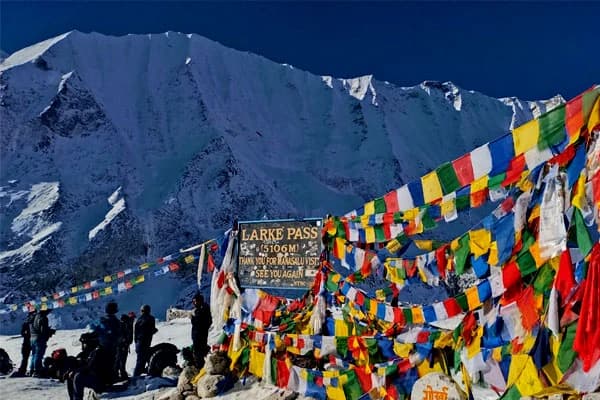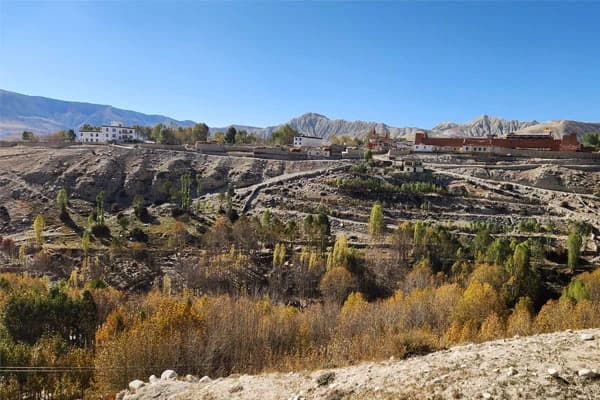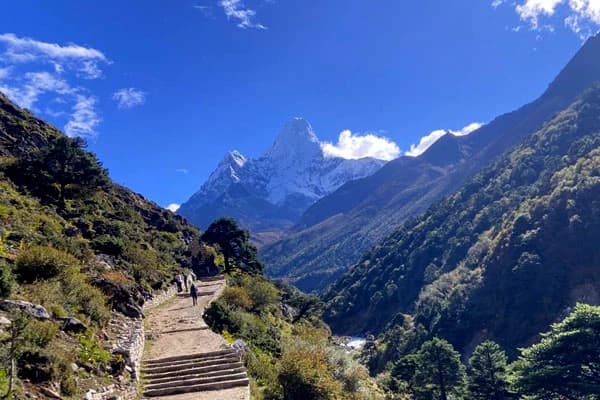What makes the Langtang Valley Trek challenging?
The Langtang Trekking Route may be relatively easier than most but challenging segments that all hikers need to be aware of. The climb reaches its highest point at Kyanjin Ri where you will experience heights reaching 4,773 meters. Going to such heights reduces oxygen levels in the air which makes breathing more difficult. The high elevation could produce feelings of dizziness and headache alongside extreme tiredness, leading to the risk of altitude sickness.
The Langtang Valley Trekking trail include multiple steep sections that lead you through rocky terrain that scales mountain slopes and ridges. The trails become exceptionally dangerous to walk along during rainy conditions because they become both narrow and slippery.

Remember, mountain weather shifts rapidly from one condition to another. The sun will shine for one minute, followed by rapid weather changes that could bring downpours or snowfall. At night, temperatures become extremely cold, particularly when trekking in higher elevations.
The daily trek duration spans between 5 to 7 hours until your legs start feeling exhausted and the walking distance on certain days reaches 10 kilometers! Maintaining good control over your body while staying mentally focused is a must to complete the Langtang Valley Trekking safely.
Weather affecting the Langtang Trek difficulty
Climate conditions heavily influence the difficulty level of walking the Langtang Valley Trek in Nepal. The selection of proper timing when it comes to visiting will determine whether your journey becomes simpler or more demanding
The two prime trekking seasons in Langtang are Spring (March-May), together with Autumn (September-November), with the bright blue skies that create perfect conditions for enjoying the mountain views without any obstruction. The conditions during this period remain pleasant because temperatures stay within comfortable levels so dry conditions make walking on the trails simpler and safer for trekkers. The trails remain safe from snow and landslide hazards as you need not worry about rain or snow. These are the perfect times to do this trek safely with fewer challenges to tackle.
The Langtang Region presents trekkers with demanding conditions during winter months because of its severe weather combined with freezing temperatures between December and February. Climbing higher elevations makes the temperature extremely cold. Even freezing cold!
The Monsoon period from June through August brings heavy rainfall to the region which transforms the trails into challenging paths with slippery surfaces due to their muddy condition. The risk of dangerous landslides rises significantly while heavy fog reduces visibility during this period. Watch out for leeches too! Winter and monsoon should be avoided if you are a beginner or trekking with families with children and old people.
What are the conditions of the Langtang Valley Trekking route?
Terrains
The Langtang Trek pass through many different landscapes in the Langtang Region. Starting at Syabrubesi, the initial path runs along the riverside of Langtang Khola while crossing through forests and farm terraces and passing through the small Tamang villages. From the lower elevations, you will see some pine forests transition into open meadows at higher altitudes. The paths between these areas range from easy, wide paths and difficult rocky pathways. Beyond Langtang Village, you will encounter climbing challenges as paths become steeper with stone surfaces and alpine meadows act like pasture land for grazing yaks. For a longer trek experience, choose the Tamang Heritage and Langtang Valley Trek, which requires 14 days to complete.
Elevation Profile
The initial part of this journey begins at Syabrubesi (1,550m) before gradually ascending each succeeding day. The daily average elevation gain for hikers falls within 500 to 700 meters, and the most difficult section of the hike occurs between Lama Hotel (2,480m) and Langtang Village (3,430m), where you will need to climb nearly 1,000 meters within a single day. Kyanjin Ri stands as the highest altitude as you reaching 4,773 meters above sea level. You can experience a holy lake at high altitude on your journey through the addition of the Gosaikunda Lake Trek, which reaches 4,380m.
Long Duration Hike
Trekking on the Langtang route normally lasts between 5 to 7 hours each day. Some days feel longer because of steep climbing and uneven terrain. The 13-day full Langtang Gosaikunda Trek unites the two stunning treks. If you are looking for a short trek, go for the Short Langtang Valley Trek (5 days) where you will walk between 4 and 6 hours each day.
Total Distance Coverage
The classic Langtang Valley Trek takes 8 days through approximately 65 kilometers round trip and the distance covered in a day can vary according to the route between 8-15 km. During theGosaikunda Helambu Trek (7 days),you will cross through a total of three different valleys while extending your walking distance. Remember that walking in the mountains feels considerably more difficult and longer than walking on flat terrain because elevating and descending slows you down.
What are the Physical Requirements for the Langtang Trek?
The Langtang Trek presents itself as suitable for anyone who maintains typical fitness standards. Don't worry! Athletic skills are not necessary. The trek difficulty level falls under the category of moderately challenging and requires of 5–7 hours duration spanning 10–12 kilometers each day which you must complete with sufficient cardiovascular fitness, strong leg muscles and stamina. A healthy condition of your lungs and heart becomes essential because altitude changes affect your breathing functions. Seek medical advice about the trek from your doctor before starting if you suffer from heart conditions or asthma. A person who maintains steady walking for multiple hours and stair climbing without feeling overly exhausted can typically finish this trek without any problem. Endurance becomes essential because you cross rugged territory with uneven and sometimes steep slopes located at high altitudes.
Common Challenges On The Trail
Trek to Langtang Valley is not as challenging as the Three Passes Trek or the Manaslu Circuit Trek, but some challenges are faced by many that may not be in their control. The path combines steep terrain with rocks alongside forested terrain, creating significant physical challenges for people who are new to mountain trekking. Trekking long distances beyond high elevations causes fatigue and discomfort in muscles and joints while creating overall exhaustion in the body. Additionally, the tea houses provide minimal rest since the walls are thin and beds lack comfort and warmth.

Dry season trails become harsh because dust irritates your eyes and throat until the wet season arrives which makes walking paths slippery. Not to forget, crossing rivers in suspension and wooden bridges can be a challenge to some. Several remote regions lack phone signal coverage so you may not be able to contact family back home. The Langtang Region weather changes from sunny to cloudy without warning which can catch you by surprise.
What Is The Risk of Altitude Sickness During The Trek to Langtang?
Any trek including the Langtang Valley Trek carries altitude sickness as its main health risk since your body struggles to adapt to the lowered oxygen levels at high elevations. It is a threat to anyone, even the pro-hikers!. The risk factor starts when you reach altitudes above 3000 meters during days 2 or 3 of the trek. The trek encompasses heights of more than 3,800 meters at Kyanjin Gompa as you can choose to climb Tserko Ri (4,984 m) or Kyanjin Ri (4,773 m. Your body must adapt to reduced oxygen levels or else Acute Mountain Sickness (AMS) becomes more likely. The symptoms include headache, dizziness and fatigue which must be promptly treated or can be dangerous. AMS develops into dangerous conditions rapidly!
Preventive Guidance to Avoid altitude sickness during the trek
- Don't rush up the trail. Your body needs to adjust slowly so increase your sleeping elevation in daily steps of 300-500 meters.
- You need to consume 3-4 liters of water each day, whether or not you feel thirsty.
- Garlic or ginger soup can warm you up from the inside while giving you the needed energy.
- Report any headache, dizziness or stomach sickness immediately because these are warning signs of altitude sickness. Inform your guide or companions immediately to assist you.
- Practice "climb high, sleep low". You should climb at higher altitudes during daylight hours while returning to lower sleeping areas.
- Descend if symptoms worsen. Moving to a lower altitude serves as the most effective treatment for altitude sickness.
- Stop at every location to monitor your oxygen level with an oximeter and notify your guide about discomfort and any oxygen readings below average.
- Talk to your doctor about taking Diamox as a prevention method before heading to a high altitude
Is the Langtang Valley Trek With Kids Possible?
The Langtang Valley Trek serves as an excellent destination for families including children who have reached ten years old to experience its attractions. Why? It offers manageable difficulty and clear paths through stunning landscapes and cultural heritage. But parents, you must monitor their children for altitude sickness and organize trek days for 3 to 5 hours rather than the typical adult 6 to 7 hours. The hiking route features family-friendly tea house rest stops, which are keen on kids! Porter service can be beneficial since they will handle your children's luggage, while also assisting when young children need rest. The trail promises a wonderful family adventure if you plan your trek properly.
Who Should Attempt The Trek?
Those seeking outdoor activities combined with trekking will find the Langtang Valley Trekking trail to be their perfect adventure choice. You need to spend hours navigating hills during this trek without facing severe exhaustion. You need to spend hours navigating hills during this trek without facing severe exhaustion. Are you a beginner?

The Langtang trek is suitable for people who want to experience Nepalese trekking but prefer to avoid high altitudes. Can you believe that almost all healthy people between 10 and 65+ successfully complete the trek with proper preparations? But, if you are suffering from any health issues, specialty lung or heart issues, it is best to avoid doing it. To enjoy the Langtang trek, adequate physical stamina is needed while being comfortable with simple lodging. A positive mindset makes the challenging points along the trail more manageable, despite your extreme physical fitness.
Essential Tips To Prepare For The Difficulty Level
Mental Preparation
- Accept that the trek will present moments when it becomes challenging.
- The key to success involves regular practice of patience and a positive mindset.
- Continuously remind yourself of the reason you chose this trekking journey.
- Staring at the mountains will help keep your spirits high despite the difficult portions of hiking.
Physical Strength
- You should start daily walking sessions that last for 30 to 60 minutes, beginning three months before your trek starts.
- Hill climbing or stair walking provides an additional advantage.
- Practice walking with your backpack when possible.
- Building stronger legs requires performing squats.
- The practice of yoga can build your balance for trekking on rocky terrain.
Health Check Up
- Prior to starting your trek, you should visit your doctor to verify proper functionality of your lungs and heart.
- Obtain all necessary vaccinations before traveling to Nepal.
- You must disclose all medications to your treating doctor before trekking.
- Obtain additional medications against altitude sickness as a preventive measure.
Hiring Guide And Porter
When you travel with a guide, they will show you the path and share information about local customs. A porter will handle your heavy bag while you remain distraction-free to enjoy the walking experience. Select a trusted local agency.
Miscellaneous
- A trekking pole will help you navigate steep terrain sections.
- Pack a reliable flashlight that includes spare batteries.
- Invest in a good travel insurance that covers up to 5,000 meters.
- Knowing basic Nepali expressions lets you greet the local people naturally.
- Since the trail lacks any ATMs, you should bring only cash.
Balanced Diet
- Consume carbohydrates including pasta and rice throughout your hiking adventure to get the energy you need.
- You should drink 3-4 liters of water every day.
- Garlic soup serves a beneficial function against altitude symptoms.
- Avoid alcohol while hiking.
- You should pack protein bars to provide fast energy between your meals.
Packing Essentials To Handle Challenges
- The most crucial packing item is sturdy hiking boots which feature ankle support. The boots need to be waterproof and start wearing your boots at home for two or three weeks in advance so they break in properly.
- Layers of clothing instead of one thick jacket. The mountain climate presents rapid fluctuations in weather conditions. Your hiking attire should contain a sweat-wicking base layer followed by warmth from fleece and finished off with a waterproof outer layer. Your outfit layers will be more versatile since they can be added or taken away as required.
- You will need either water purification tablets or a filter bottle to clean up stream water for drinking purposes. Buying water in bottles can become very costly because it creates excessive plastic waste.
- First aid kit with blister bandages, pain medicine, stomach medicine, and altitude sickness pills. The trail environment often brings forth basic health issues since the mountains do not offer medical assistance.
- The sleeping bag should be designed for temperatures down to 0 degrees Celsius (32 degrees Fahrenheit). Guests staying at tea houses should note that basic blankets are available yet insufficient to withstand the frigid mountain temperatures during nighttime hours.
- Headlamp with extra batteries for finding your way around at night. The tea houses possess restricted access to power supply while their bathroom facilities remain outdoors. A hands-free light provides night-time visibility so you can read or walk at night.
- Trekking poles will distribute knee pressure when descending steep inclines. The poles supply support for balance control as you traverse slippery terrain and stream crossings.
How Guide And Porter Make the Langtang Valley Trek Easy?
Want to know the best way to make your Langtang Trekking safe and easy? Having guides and porters will simplify your journey while adding enjoyment to your adventure. The guide serves as an interactive walking map that shows you all the optimal routes together with unseen attractions. Locals understand their Nepali language so they can interact with them on your behalf while sharing the local tales. The guide protects your safety by using their expertise when weather conditions become unsafe or when you become unwell.
Porter, reduce your burden significantly by carrying your hracy backpack. The effort you save thanks to porters allows you to fully appreciate the natural scenery. Your trip becomes less strenuous since carrying only a small day pack during your trek reduces back and leg pain. Guides and porters improve your travel experience while increasing your safety throughout your journey.
Is Langtang Trek Safe to do?
The Langtang Trek provides a safe experience when you maintain the necessary safety measures. Multiple people successfully hike throughout this area annually since the paths are clearly marked and well-managed teahouses. The 2015 earthquake destroyed certain areas but trail maintenance efforts have restored them to their former state.
Under the "no solo trekking" regulation it makes sense to trek alongside a guide. Experienced guides possess expertise used to prevent dangers that stem from weather conditions and altitude sickness risks. The terrain, high altitude and weather conditions can be a challenge but with the right gear and support, you won't face severe problems. By preparing well and behaving respectfully toward mountain territories, your Langtang Trekking experience will be both secure and fantastic.
Langtang Valley Trek without a guide: No More Independent or Solo Treks
Planning on a solo trek to Langtang? Starting from February 2025, all treks to Langtang Valley require a government-licensed guide for safety. Every hiker needs to bring a guide who holds a valid government license and travel in a group of at least two (except the guide). The implementation of this new rule emerged from the risky terrain, unpredictable weather patterns and altitude sickness risks in the area.
Officials conduct routine guide checks in Syabrubesi and Lama Hotel and if you do not have a guide, you will be sent back. A guide enhances your safety while offering emergency assistance and facilitates cultural learning while generating profits for the local community.
Is Langtang Valley Trek Right For You?
Do you think you can take this moderate difficulty challenge? You should consider doing the Langtang Trekking if you need to see mountains while staying within achievable altitudes. Those with average fitness capabilities who can walk 5-6 hours each day during multiple trekking days should consider this destination. Want to avoid the popular routes of Everest and Annapurna? This trek is an optimal choice! The combination of picturesque landscapes and cultural immersion and moderate physical requirements within Langtang makes it suitable for numerous nature enthusiasts.
From guide to logistics, Destination Himalayas Treks and Expedition has got you covered in your upcoming trek to Langtang Valley. We can customize the Langtang Valley Trek Itinerary as you wish! Check out our other Langtang Region treks for diverse experiences. Contact us now!







